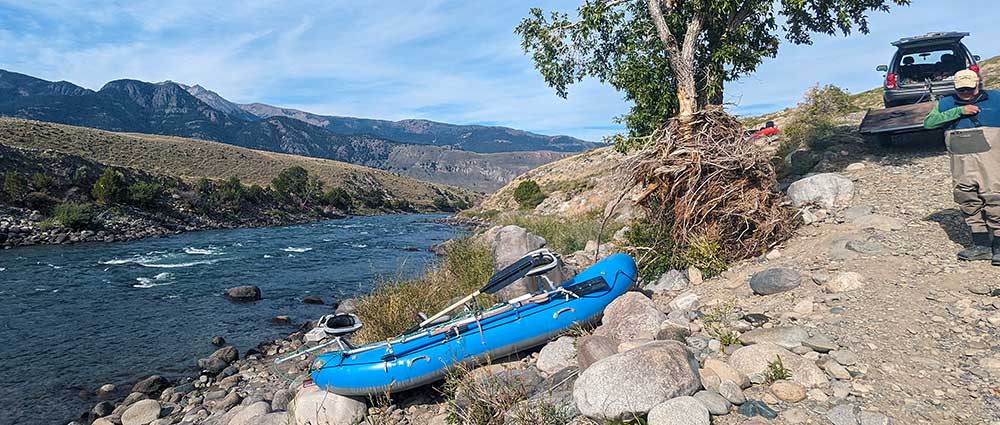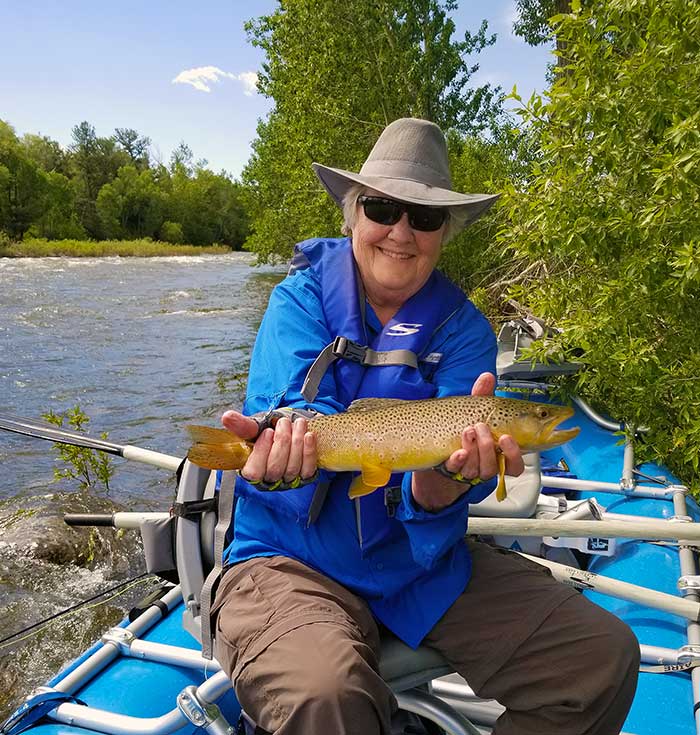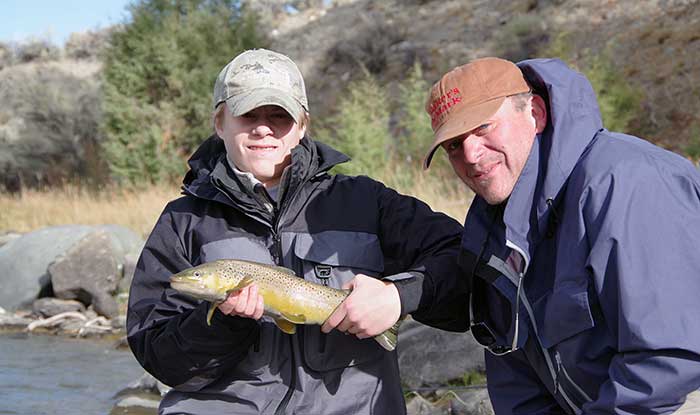Yellowstone River fishing trips are our bread and butter...
Yellowstone River fishing trips are the core of our Montana fly fishing guide service. The ‘Stone is the river we float the most and the one for which we have developed the majority of our custom fly patterns. Yellowstone floats require the least travel time, can produce lots of fish and big fish (sometimes both in one day!), and can accommodate anglers of any skill level and almost any fitness.
We run over 120 miles of the Yellowstone in Montana, meaning it’s possible to float ten days straight without seeing the same water twice. Some stretches are fast and turbulent, with tough access and whitewater thrills along with great fishing. Some stretches are mellow and scenic. They offer great fishing too.
We want to draw attention to the fact that we run more “Upper Yellowstone” float trips than any Livingston-based outfitter. In fact, Walter has run Yankee Jim Canyon (a section of the Upper Yellowstone) more than any other guide—ever! This whitewater stretch near Gardiner is the Yellowstone’s most productive stretch, but it requires a skilled guide with the right boat. It also requires clients up for whitewater adventure. Sound good? We’re your outfitter and Walter is your guide.

Yankee Jim Canyon holds lots of trout that love dry flies, but also several intense rapids. When Walter was younger and dumber he ran all his float trips in a high-sided drift boat. Nowadays he recognizes his mortality (and that of his clients) and uses a raft on whitewater stretches.
…But who wants to live on bread and butter?
The Yellowstone’s our home water, but when conditions dictate, to shed crowds, or just for a change of pace, we run trips on plenty of other nearby rivers.
The Madison River and Missouri Rivers are prime bets during the spring melt when the Yellowstone is muddy. They’re also very beginner-friendly, and the Madison is just a short drive from Bozeman airport. You might not even need to rent a car!
To beat the summer crowds, we love the Boulder and Stillwater Rivers. These are smaller, rougher rivers that require our whitewater rafts—and they flat out produce fish.

Small whitewater rivers full of aggressive trout that love dry flies get a thumbs up.
2024 Float Trip Rates and Options
Guided drift fishing trips are available from early March through early November. We can arrange floats for anglers of all skill levels, fitness levels, and preferred techniques. Certain rivers and certain stretches of river are better at different times of year than others, and for different clients. Visit our Guided Trip Destinations page or the blog posts linked to below to learn more, or just drop us a line or give us a call to talk things over.
Because we have both drift boats and rafts (and because we’re willing to beat them up), we can float a wider range of rivers than most guides, and also access specific sections of rivers others cannot. While no quality river in Montana is devoid of other guides during the core season, we often run water where we go hours rather than minutes without competition. Unpressured fish are aggressive fish.

Quality “boat ramp” on the Yellowstone River. You can see why we only launch rafts here…
We offer full-day and half-day river floats during the core season. In spring and fall we also offer “shoulder season” trips that run longer than a half-day but shorter than a full day. The maximum number of clients per guide is two on all float trips. Additional clients required additional guides.
- Full-Day Float Trips: $625 for one angler, $650 for two. Available April 1 through October. Available on all float rivers. Additional fee of $25 applies to trips on the Upper Yellowstone, Stillwater, Upper Madison, and Missouri Rivers due to increased fuel costs and/or private ramp access fees.
- “Shoulder Season” Float Trips: $575 for one or two anglers. Available March 1 through May 14 and October 1 until mid-November. Yellowstone and Lower Madison Rivers only. Additional $25 fee applies to trips on the Upper Yellowstone when we use private ramps.
- Half-Day Float Trips: $525 for one or two anglers. Available March 1 (ice-permitting) through November 15. Yellowstone River only except May 1 through June, when the Lower Madison is also available.
- Standard terms apply.
Floats are available from early March through early November. Early and late season availability is variable due to ice and inclement weather. Spring Missouri River tailwater trips require booking 2+ consecutive days. Our guides stay in Wolf Creek, Montana. We can arrange lodging for you if you prefer.

This is one of the larger rainbow-cutthroat hybrid (“cuttbow”) trout you’ll ever see, and this one ate a dry fly!
Montana Float Fishing Trips by Season
We run floats whenever it’s warm enough. Each season has its top fisheries and its pluses and minuses. The following chart and discussion might help you decide when to come if you haven’t already.
Note that float-wade trips may be better options at certain times of year and on certain waters. Basically, the colder or lower the water gets, the more a float-wade makes as much or more sense than a standard float.
The following chart gives a sense of the quality of float trips at different times of year, as well as when we float them. Yellowstone River fishing trips are available throughout the float season except during the spring melt. Other rivers are available during smaller windows, though we almost always have 2–3 solid options available during the core late April through October season.

Early Spring Float Trips
Mid-March through early May is a sleeper season for Montana float fishing trips. Big fish are on the prowl after a long, cold winter, and there are seldom large numbers of other guided float fishing trips out on the water. It can be awfully cold, though, and the fishing isn’t as consistent as it is during summer and early fall.
Yellowstone River fishing trips are our top bet at this time of year, but we also float the Lower Madison River and occasionally the Boulder and Stillwater Rivers, when they’re high enough (though float-wade trips are better on these rivers at this time).

Late Spring Float Trips
Early May through sometime in the latter half of June or the first week of July is runoff season. The spring melt brings high, muddy water that makes most local rivers impossible to fish. But not all local rivers. The Lower Madison River sees its best fishing of the year at this time. The Missouri River is very crowded but also very good. This makes for a good excuse for us to take a multi-day road trip from Livingston.
The “Maddy” and “Mo” are our primary late spring destinations. That said, the Yellowstone and especially the Boulder sometimes experience “runoff breaks” when cold weather slows the melt for a day or two at a time. These breaks are impossible to plan for, but almost always offer spectacular fishing for lucky anglers in the area when they occur.
As soon as the melt begins dropping for good, which in drought years can happen as early as June 10–15, we’re back to the Boulder and Yellowstone.

The Boulder river comes into shape fast during “runoff breaks.” The river was well into the bushes here.
Early Summer Float Trips
The month following the end of the runoff (usually the whole month of July) offers comfortable weather, the largest number of Montana float rivers in good shape, eager trout, and excellent hatches that produce good dry fly fishing (though early fall has even better hatches).
Unfortunately, early summer also offers high crowds of other anglers. That’s understandable given that early summer typically offers our most consistent float fishing of the year, if not the most beginner-friendly, as well as some good shots at big brown trout on the Yellowstone.
Our top destinations for Montana float fishing trips at this time are the Yellowstone and the Boulder, but we also fish the Stillwater and occasionally the Madison. Early starts are usually necessary this time of year to beat these crowds. Starting early also helps beat the heat that can make fishing after midafternoon slow. Occasionally we have to meet as early as 5:30AM, though 7:00 is a lot more common.

Early summer offers good chances at big brown trout on the Yellowstone.
Late Summer Float Trips
In August and early September, float rivers run low and clear and aquatic insects are at their low ebb. This means the trout love to eat grasshoppers and ants. Fishing is slower-paced than it is earlier in the summer, but the fish can be a bit spookier.
While we don’t catch as many big fish overall in late summer as we do in early summer, we catch more of them on dry flies. For many anglers, there’s nothing better than seeing a big trout come up and smack a grasshopper, and this is prime time for hopper fishing. It’s also prime time in Yankee Jim Canyon, when the deep, turbulent water keeps the fish aggressive.
Our favorite float rivers at this time are the Yellowstone and the Stillwater.

Late summer is prime time in Yankee Jim Canyon, even with teenagers.
Early Autumn Float Trips
September through early October is transition time. On warm, sunny days the fish often still prefer grasshoppers. When it’s cold and wet the fall aquatic insect hatches are heavy and the riffles and pools fill with rising trout.
Crowds decline as the weather cools, and we can often meet a bit later in the morning since the water takes a while to warm up. Often the best fishing is from 1:00PM until 5:00PM, whereas in the summer the good fishing is usually over around 3:00. Yellowstone River fishing trips are best in early autumn, but the Stillwater River and Madison River are also good options.
Early autumn is a great time for beginner anglers, since the abundant native whitefish are getting ready to spawn and aggressive. It’s also a great time for expert dry fly fanatics. Let’s put it this way: Walter is a dry fly nut, and early autumn is his favorite time to guide float trips.

Late Autumn Float Trips
Die-hard anglers love mid-October through mid-November float trips. While dry fly fishing is still good for a few hours in early afternoon, our focus shifts to pursuing large trout with nymphs and streamers. The fishing can be tough, with both the weather and the fish refusing to cooperate, but the rewards are worth it. We usually catch the biggest brown trout of the year in late fall.
Yellowstone River fishing trips are the top bet in late autumn, but we also fish the Madison and even some “shoot for the moon” sections of the Missouri and Jefferson Rivers, where clients might see a brown trout of a lifetime or might see nothing at all.
